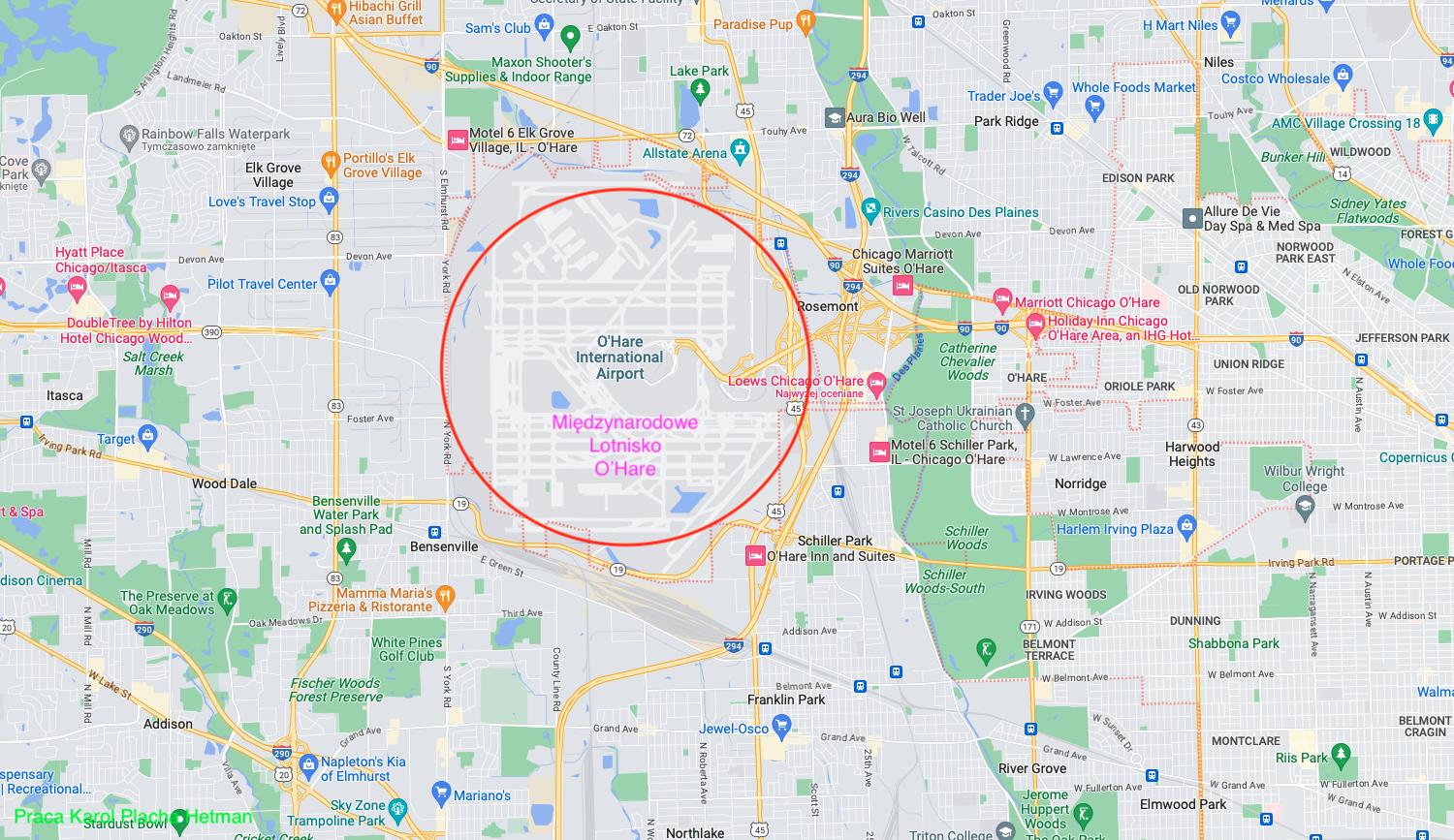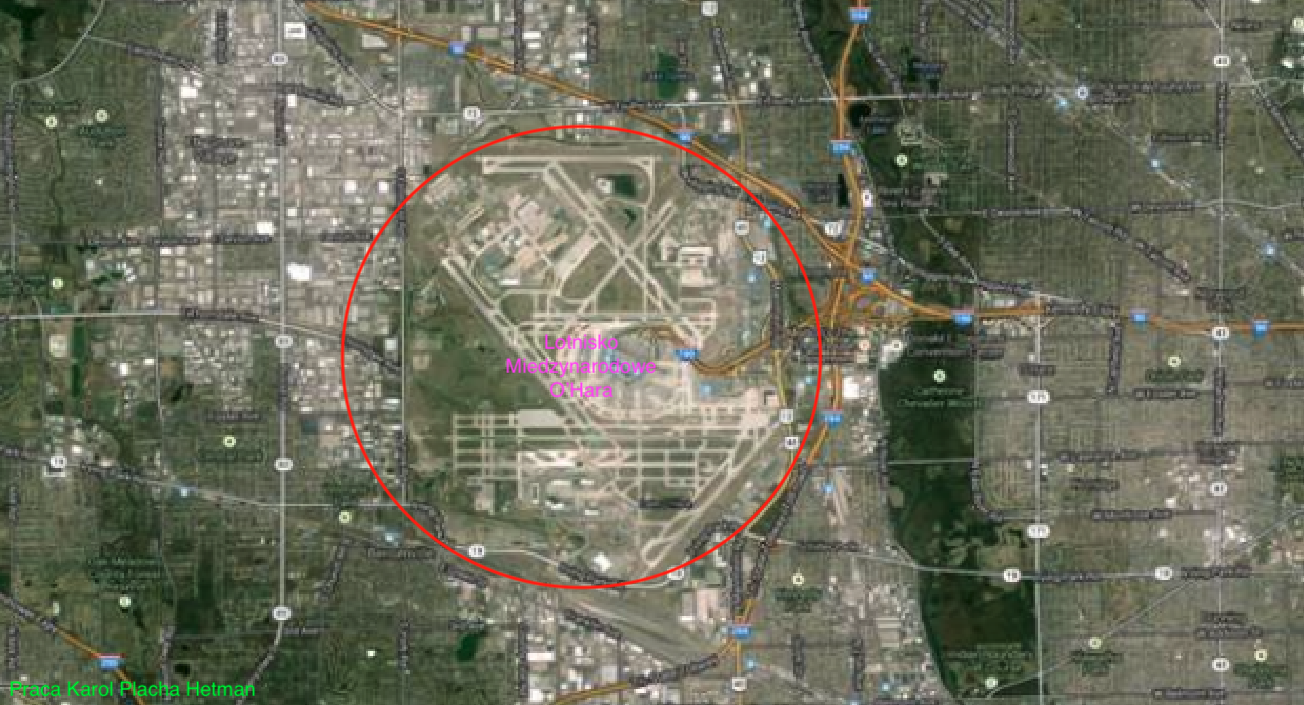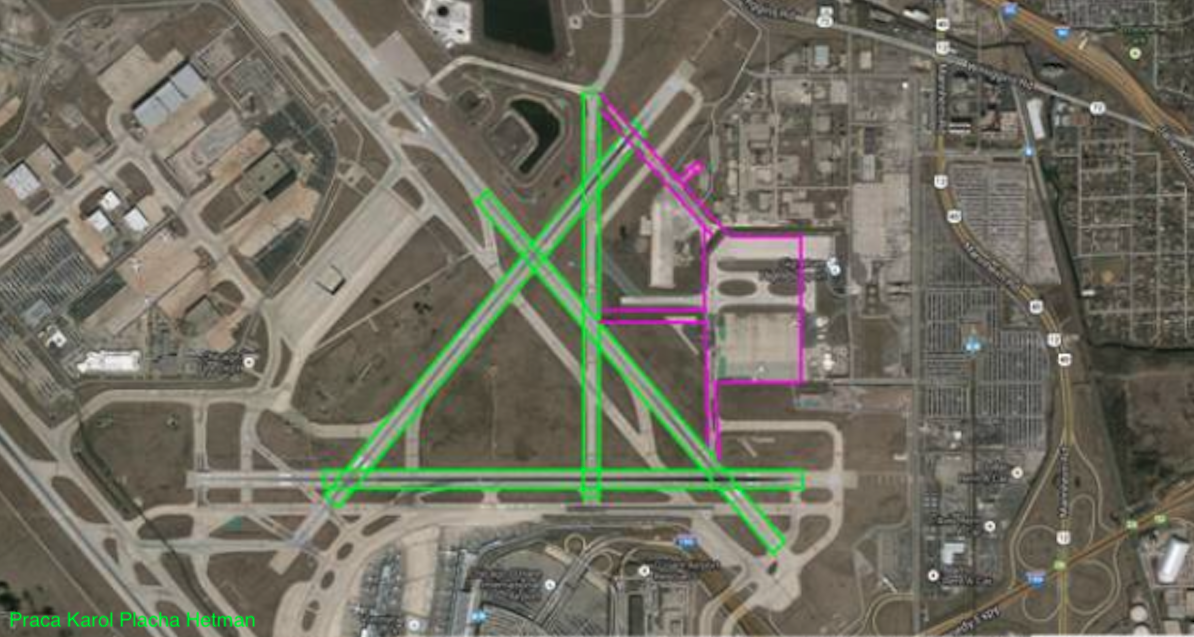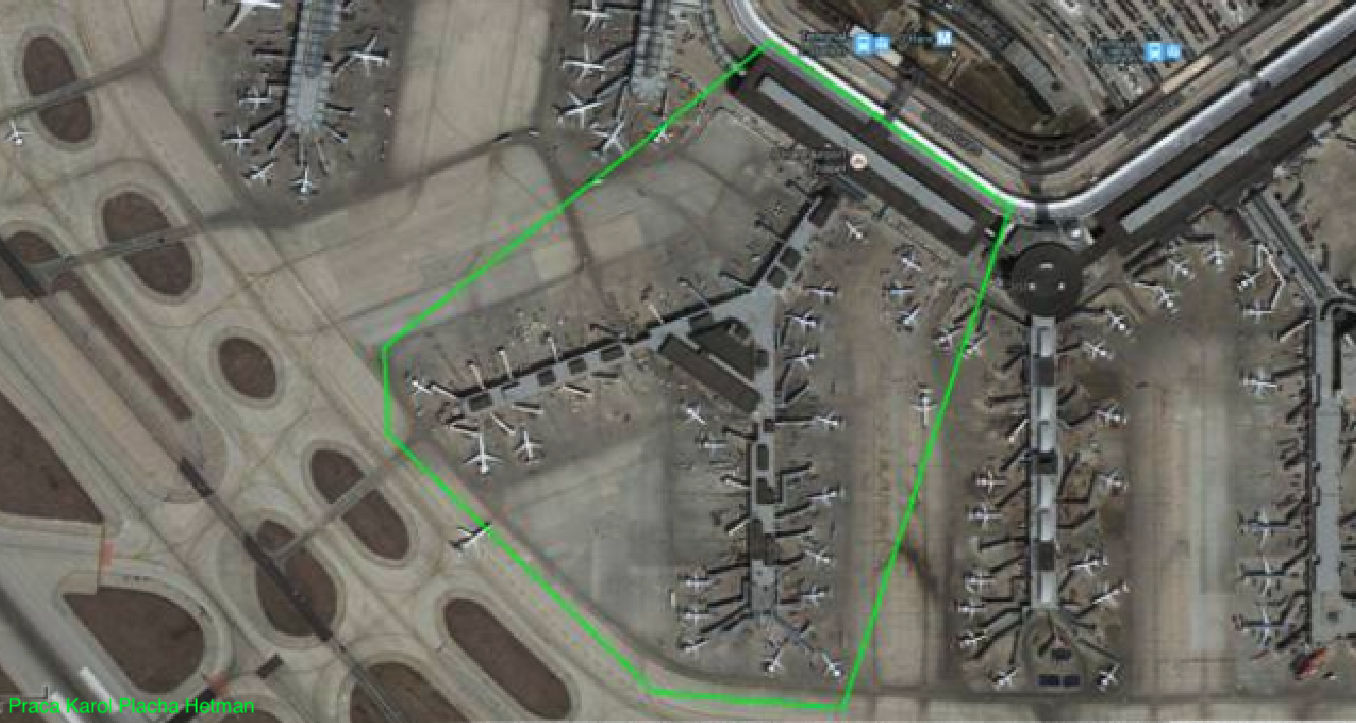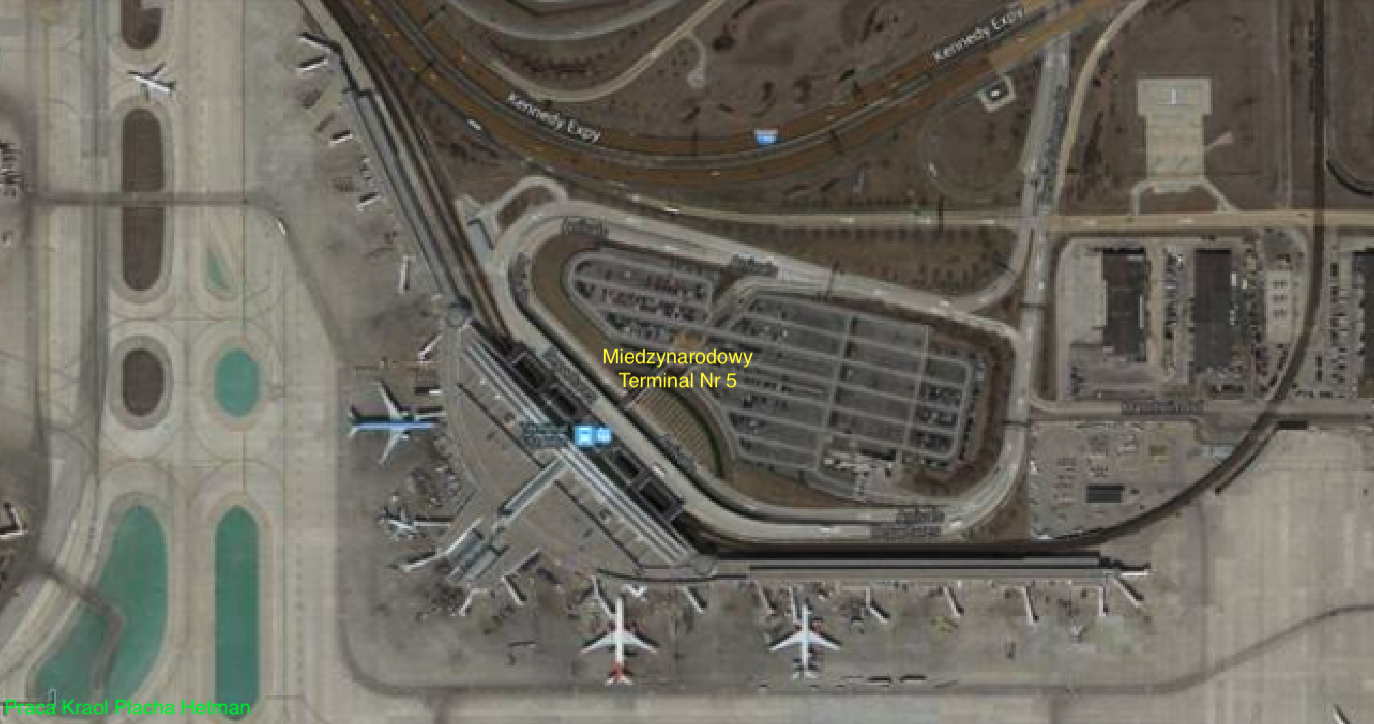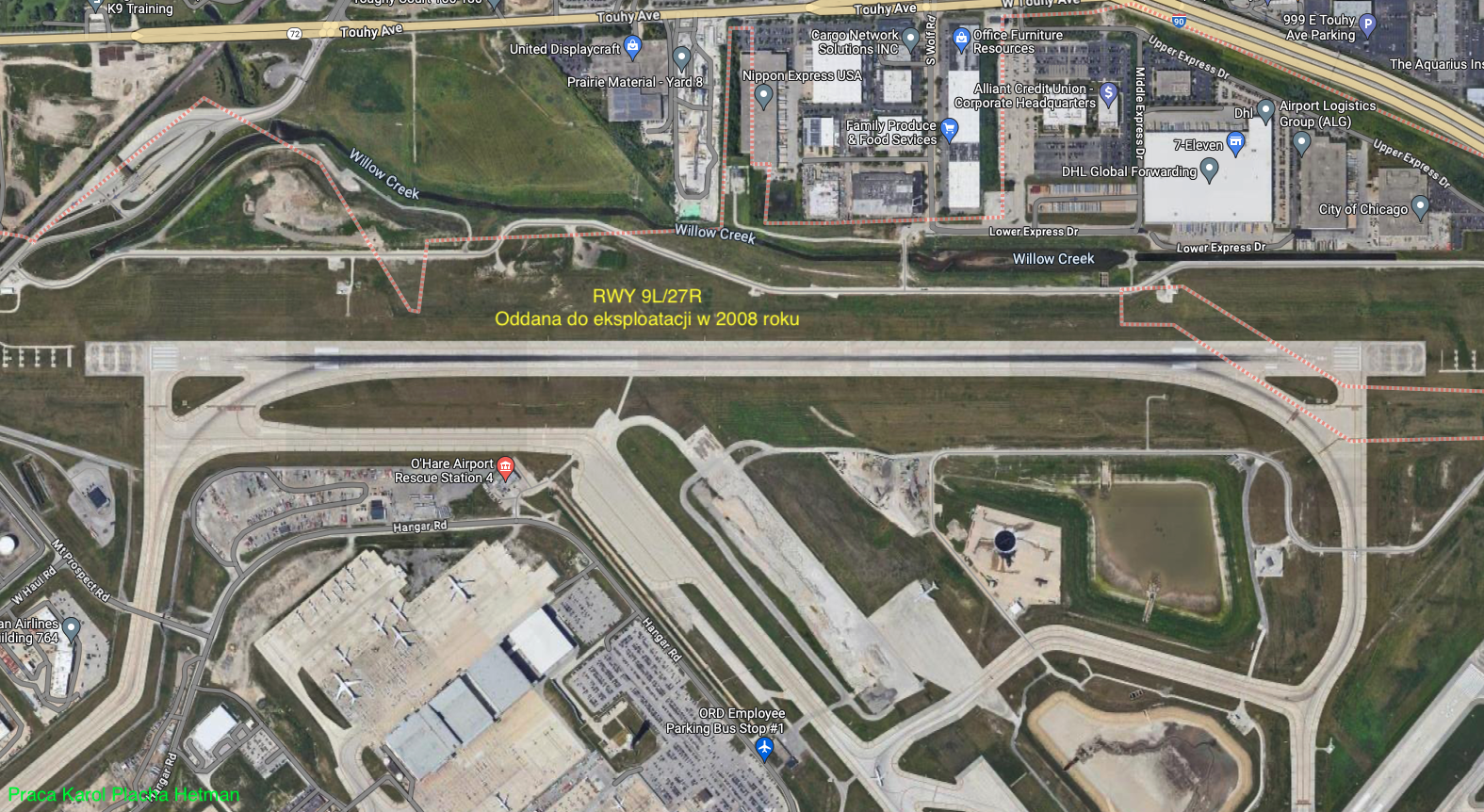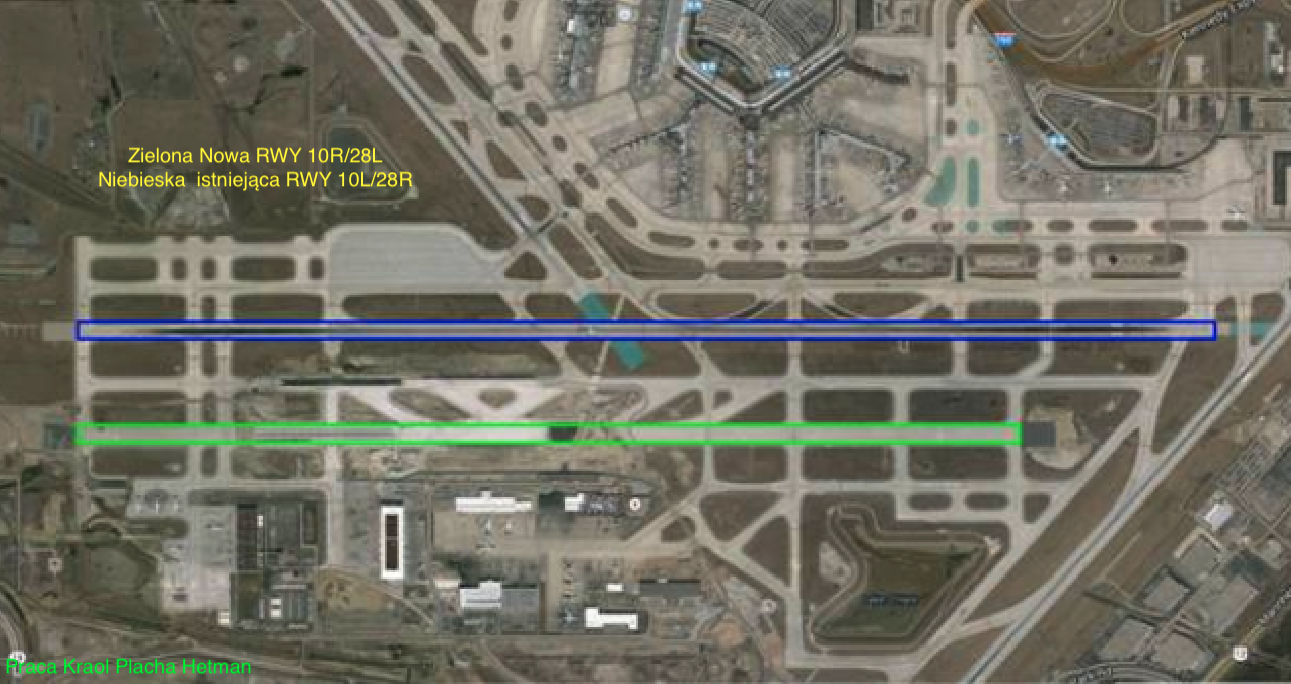Chicago 2013-11-12
Lotnisko Chicago – O’Hare.
Współrzędne geograficzne: 41.976 N 87.908 W.
Chicago.
Do napisania o lotnisku Chicago-O’Hare skłoniła nas najpopularniejsza wśród Polaków trasa lotnicza Warszawa-Chicago. Wszystko za sprawą Polaków i Amerykanów pochodzenia Polskiego.
USA to kraj z największą Polonią na świecie. Główne miejsca zamieszkiwania Polonii w USA to miasta: Chicago, Denver, Detroit, Los Angeles, New York i Seattle. Szacuje się, że mieszka w Stanach Zjednoczonych blisko 10 mln osób pochodzenia polskiego, a około 600 tys. z nich używa języka polskiego na co dzień. Chicago, jest drugim na świecie, po Warszawie, miastem pod względem populacji Polaków. Pierwsi Polacy przybyli do Ameryki Północnej dwanaście lat przed tak zwanymi "Pielgrzymami", którzy dotarli do Massachusetts w 1620 roku. Pod koniec XVIII wieku, w czasach rozbiorów Rzeczypospolitej, niektórzy Polscy patrioci, wśród nich Kazimierz Pułaski i Tadeusz Kościuszko, wyjechali do Ameryki, żeby pomóc w walce o jej niepodległość. Polacy zaczęli emigrować w większych ilościach do Stanów Zjednoczonych już w XIX wieku, po powstaniach narodowych. Głównie osiedlali się w stanie Nowej Anglii i w stanie Illinois. Kolejne duże fale emigracji z Polski do USA zrodziły się z powodów zarobkowych (od drugiej połowy XIX wieku aż do 1939 roku, a potem po 1980 roku. Z przyczyn politycznych (po II wojnie światowej) i z przyczyn ekonomicznych i politycznych (80-lata XX wieku). Według danych oficjalnych, ponad 2,2 miliona imigrantów Polskich dotarło do USA w okresie 1820 – 1914. Oficjalny spis ludności w 1940 roku, podawał 993 479 Amerykanów urodzonych w Polsce oraz 2 416 320 tych, którzy w dzieciństwie używali języka polskiego. W 1958 roku, Kongres Polonii Amerykańskiej szacował liczbę Amerykanów pochodzenia polskiego na 6 mln 372 tysiące. Największy udział mieli oni wśród mieszkańców stanu Connecticut (11,1%), Illinois (9,6%) i New York (8,3%).
Największe poza Polską skupisko Polaków i ludności pochodzenia polskiego (ponad 1,3 mln osób polskiego pochodzenia, w tym około 250 tys. mówiących na co dzień po polsku) jest w Chicago. W Chicago istnieją trzy głównie polskie dzielnice, z których najbardziej znana jest Polish Village. Do 80-lat XX wieku, spora część Polaków w Chicago mieszkała w dzielnicy Polish Village, potocznie – od parafii i kościoła św. Jacka – nazywanej Jackowem. W następnych latach, pod naciskiem przesuwających się na północny zachód imigrantów latynoskich, Polacy zaczęli przemieszczać się – wzdłuż ulic Belmont Avenue, Irving Park Road, Milwaukee Avenue i Central Avenue na północ i na zachód; coraz większa ich liczba zamieszkuje bliższe i dalsze przedmieścia. Chicago to wielkie centrum zorganizowanej Polonii. Siedziba władz centralnych Kongresu Polonii Amerykańskiej (Polish American Congress – PAC), Związku Narodowego Polskiego (Polish National Alliance – PNA), Zjednoczenia Polskiego Rzymsko-Katolickiego (Polish Roman-Catholic Union – PRCU), Związku Polek w Ameryce (Polish Women’s Alliance of America – PWAA), Związku Podhalan w Północnej Ameryce (Polish Highlanders Alliance of North America – PHAA) i wielu innych organizacji. Najstarszym Polskim zabytkiem jest kościół św. Stanisława Kostki zbudowany około 1870 roku, a przy Zjednoczeniu Polskim Rzymsko-Katolickim mieści się bogate w zbiory Muzeum Polskie w Ameryce. Do dzisiejszego dnia Chicago jest powszechnie uznawane za wielki ośrodek Polonii amerykańskiej. W Almanachu Polityki Amerykańskiej (ang. Almanac of American Politics) z 2004 roku, napisano, że "Nawet dziś, w dzielnicy Archer Heights, ledwo można przejść jeden blok bez usłyszenia języka polskiego" (Archer Heights to dzielnica położona na południowym zachodzie miasta wzdłuż ulicy Archer Avenue, zamieszkana w większości przez imigrantów z Podhala; przy Archer Avenue mieści się Dom Podhalan. Polacy są najliczniejszą grupą etniczną wśród właścicieli nieruchomości w Chicago.
Lotnisko O’Hare.
Chicago (stan Illinois) to najbardziej znane dla Polaków miasto w USA, z uwagi na największą populację Polonii. Chicago dysponuje dwoma międzynarodowymi lotniskami; O’Hare i Midway. O’Hare (kod IATA-ORD, kod ICAO-KORD). Leży 27 km na północny zachód od centrum miasta, w jego granicach administracyjnych. Nosi nazwę na cześć Amerykańskiego pilota wojskowego, Edwarda "Butcha" O’Hare.
Lotnisko od samego początku należało do najważniejszych portów lotniczych żeglugi powietrznej w USA i na świecie. Można powiedzieć, że nikt nie lubi tego portu lotniczego, ale wszyscy tu chcą latać. Wynika to z kilku przyczyn, z których na pierwszym miejscu wysuwa się historia. Otóż, tutaj swoją siedzibę założyło jedno z największych na świecie towarzystw lotniczych United Airlines, które jak sama nazwa wskazuje, powstało z połączenia kilku mniejszych firm. Już w 30-latach XX wieku, miasto utrzymywało stałe połączenia pocztowo-pasażerskie z Detroit, Buffalo i New York.
W dniu 8.05.1926 roku, w Chicago oddano do użytku lotnisko Municipal Airport, które obecnie znane jest jako Midway. Lotnisko to, szybko okazało się za ciasne. Kosztem około 10 000 000 $, przez 10 lat zostało powiększone i rozbudowane. Lecz możliwości dołączenia kolejnych terenów zostały wyczerpane.
Po ataku na Pearl Harbor zmieniło się myślenie Amerykańskich planistów. Koniecznym stała się budowa nowych zakładów zbrojeniowych w głębi kraju. W przeciągu kilku dni wybrano lokalizację pod nowe fabryki i lotniska. W Chicago wybrano tereny położone w pobliżu niewielkiej miejscowości Orchard Place, założonej w 1840 roku, w której w 1854 roku, zbudowano przystanek linii kolejowej na trasie Illinois i Wisconsin, który nazwano Depot Place Orchard. To miejsce było jednym z wielu możliwych miejsc zidentyfikowanych podczas przeszukiwań w 1930 roku i ze względu na jego bliskość do miasta, dostępność wysoko wykwalifikowanej siły roboczej oraz łatwego dostęp do głównych środków transportu, zwłaszcza kolei. To tu postanowiono wybudować fabrykę samolotów i lotnisko. Firma Douglas postanowiła budować tutaj cztero-silnikowe samoloty transportowe C-54 Skymaster.
W czerwcu 1942 roku, plan został zatwierdzony i kupiono 1 790 (inne dane 1 300) akrów ziemi pod budowę fabryki i lotniska. Administracja wyasygnowała na ten cel 20 000 000 $, łącznie z budową samolotów. Mimo lokalnych protestów, w dniu 18.06.1942 roku, tutejszy sędzia William J. Campbell, podpisał umowę na to zamówienie i rozpoczęto wykup ziemi. W lipcu 1942 roku, trwały już szeroko zakrojone prace. Pierwszymi inwestycjami było doprowadzenie linii energetycznej, centralnego ogrzewania i melioracja terenu. Pierwszy budynek zaczęto wznosić w dniu 30.06.1942 roku, a główną halę produkcyjną w dniu 24.08.1942 roku. W listopadzie 1942 roku, pierwszy etap budowy fabryki został przekazany firmie Douglas, do pracy. Z uwagi na braki w stali, głównym materiałem budowlanym było drewno. Nie był to problem, bo planowano fabrykę zlikwidować po wojnie. Główny obiekt produkcyjny miał powierzchnię 2 miliony stóp kwadratowych, zbudowany wyłącznie z drewna, został uznany za największą fabrykę z drewna na świecie. Niepewność co, do jakości drewna przewidzianego do budowy, zmotywowała inżynierów do zastosowania wzmocnionej struktury.
Także poważnie został potraktowany problem pola wzlotów. Zaprojektowano je zgodnie z najnowszymi trendami. Wybudowano na nim cztery drogi startowe RWY. Główną drogę startowa umieszczono na kierunku północny-zachód – południowy-wschód (northwest-southeast). Było to podyktowane względami położenia lotniska Municipal Airport (późniejsze Midway) w warunkach lotu według przyrządów. Dodatkowo lotnisko Municipal Airport uchodziło za ówczesny wzór ruchu, dla względów bezpieczeństwa i eksploatacji w warunkach lotu według przyrządów. Nawierzchnię wykonywano z grubszego niż zwykle betonu, bo zbrojenie stalowe było znacznie ograniczone, z uwagi na wspomniane braki stali. Każda RWY miła długość 5 500 feet, szerokość 150 feet oraz grubość 15 inches (cali). Beton układano warstwami (7-10 warstw). Ostatnią RWY ukończono w dniu 15.08.1943 roku, ale starty z lotniska prowadzono już od wiosny 1943 roku. Całkowita powierzchnia utwardzona to 1 300 000 square feet (stóp kwadratowych).
Opis zdjęcia: Układ lotniska w 1943 roku. Zielone – RWY, Fioletowe – płaszczyzny postojowe i drogi kołowania.
Cztery RWY miały następujące kierunki; 0/18, 4/22, 9/27, 14/32. Najważniejszą była ta na kierunku 14/32, gdyż jest to RWY na wprost do lotniska Municipal Airport (Midway) i nie sprawiała problemów nawigacyjnych. Najrzadziej była eksploatowana RWY na kierunku 0/18 i już po II wojnie światowej była wykorzystywana, jako droga kołowania. Taki układ pola wzlotów był wówczas standardem. Pozwalał na stosunkowo małej powierzchni zagwarantować bezpiecznie podejście do lądowania z każdej strony. Jednak taki układ powoduje, że wszystkie RWY się ze sobą krzyżują i uniemożliwiają jednoczesne lądowanie dwóch maszyn.
Fabryka nosiła nazwę Assembly Plant Chicago (Montowania Samolotów Chicago). W dniu 30.07.1943 roku, pierwszy samolot transportowy C-54 Skymaster, wzbił się w powietrze. Jego niezakłócona produkcja trwała do października 1945 roku. Zbudowano 655 samolotów. W dniu 18.07.1944 roku, budynek administracyjny spłonął. Tylko dzięki dużym odległościom między poszczególnymi budynkami pożar nie zajął hali montażowej. Budynek szybko odbudowano. Na lotnisku wojsko wykonywano testy na zdobycznych samolotach germańskich, włoskich i japońskich.
Po zakończeniu II wojny światowej teren ten powrócił pod zarząd miasta Chicago. Z końcem 1945 roku, Komitet mianowany przez burmistrza Chicago zdecydował, że Orchard Field będzie nowym lotniskiem dla Chicago. Powodem był brak możliwości powiększenia lotniska Midway. W 1949 roku, Rada Miasta Chicago zmieniła nazwę Orchard Field na Chicago-O’Hare International Airport, na cześć lotnika marynarki wojennej porucznika komandora Edward H. Butch O’Hare, który zginął podczas II wojny światowej. Jednak przystosowanie lotniska do obsługi komercyjnej trwało bardzo długo. Głównym powodem były obawy lokalnych społeczności, o znaczny wzrost hałasu emitowanego przez nowe samoloty turboodrzutowe.
Lotnisko O’Hare oficjalnie otwarto dla komercyjnego ruchu powietrznego w 1955 roku, i już w pierwszym roku obsłużyło 176 902 pasażerów. W 50-latach, wyremontowano i wydłużono RWY 14/32 oraz RWY 9/27. Nieco później to samo uczyniono z RWY 4/22. W 1958 roku, oddano do użytku nową RWY R14/L32 (Nr 4), znacznie oddaloną od już istniejącej i przebiegającą przed terminalem Nr 1. Droga ta otrzymała równoległą drogę kołowania oraz aż sześć szybkich zjazdów, rozmieszczonych co 1 000 feet. Dostrzeżono, że szybkie zjazdy umożliwiają zwiększenie liczby operacji lotniczych. Warto wspomnieć także o terminalu Nr 1. Pierwszy terminal zbudowano z południowej strony RWY 9/27. Był to stosunkowo prosty budynek dworcowy z prostopadłym do niego pirsem. Obecnie (2013 rok) nieistniejącym. Do budynku dworcowego dobudowano pierwszy z prawdziwego zdarzenia terminal Nr 1. Został on zbudowany na planie litery Y i wielkością odpowiadał później zbudowanym terminalom Nr 2 i 3, już wówczas planowanych. W późniejszym okresie terminal Nr 1 został przebudowany i obecnie (2013 rok) wygląda zupełnie inaczej. Wokół planowanych terminali na planie niepełnego kola wpisano główne drogi kołowania. Są one zdwojone i istnieją do chwili obecnej. Pozwalają na bezpieczny ruch kołowy samolotów.
W 1959 roku, postanowiono powiększyć obszar lotniska o kolejne tereny. W dniu 1.04.1959 roku, zainaugurowano rozszerzenie o kolejne 7 200 akrów ziemi. Głównie na południe od istniejącego pola wzlotów. Na nowym terenie rozpoczęto budowę kolejnego terminalu, hangarów, parkingów, poczty i innych budynków (catering, wypożyczalnię samochodów). W 1962 roku, oddano do użytku nowoczesny terminal Nr 2, pierwszy na świecie z rękawami dla wejścia pasażerów na pokład samolotu. Składa się on z dużego budynku dworcowego i pirsem na planie litery Y. W 1962 roku, zdecydowano o przeniesieniu całego ruchu komercyjnego z lotniska Midway (planowano go zamknąć, co jednak nie nastąpiło) na lotnisko O’Hare. W efekcie w 1962 roku, lotnisko O’Hare obsłużyło blisko 10 000 000 pasażerów. Wówczas lotnisko uzyskało miano najbardziej ruchliwego lotniska świata. W dniu 23.03.1963 roku, lotnisko O’Hare zostało oficjalnie odwiedzone i zadedykowane przez prezydenta John F. Kennedy.
W kolejnych latach zbudowano Terminal Nr 3. Bardzo zbliżony wyglądem do Terminalu Nr 2. W 1978 roku, w USA nastąpiła deregulacja federalnego prawa lotnictwa komercyjnego podpisana przez prezydenta Jimmy Carter. W efekcie ruch lotniczy jeszcze bardziej wzrósł. Nastąpiła kolejna rozbudowa. Przebudowano Terminal Nr 1, a między Terminalem Nr 2 i 3 powstał kolejny pirs. Wówczas to port przyjął układ zbliżony do aktualnego. Jeszcze z początkiem 70-lat wybudowano kolejną drogę startową RWY 10/28 najbardziej wysunięta na południe (Nr 5) która wówczas krzyżowała się z RWY 14R/32L. W końcu 80-lat udało się pozyskać kolejny teren, na którym wybudowano już szósty RWY 4R/22L. Była to pierwsza droga startowa, która z założenia nie krzyżuje się z innymi. Droga ta jest równoległa do starej drogi startowej RWY 4/22, którą teraz oznaczono RWY 4L/22R, a które są znacznie od siebie oddalone.
Musimy wiedzieć, że lotnisko O’Hara, mimo że nazwane jest międzynarodowym, to jest przede wszystkim lotniskiem krajowym. Loty międzynarodowe są marginesem. Mimo to ruch stale wzrastał. Dlatego zdecydowano o budowie kolejnego Terminalu, który oznaczono Nr 5. Numer 4 pozostawiono dla kolejnego Terminalu przeznaczonego dla ruchu krajowego, który jeszcze (2013 roku) nie powstał. Terminal Nr 5 zbudowano na wschód od istniejących terminali i nie łączy się z nimi. Terminal składa się z budynku dworcowego i dwóch pirsów. Terminal Nr 5 ma 21 bramek w jednym pirsie. Przyjmuje wszystkie przyloty z zagranicy, oprócz lotów odprawianych w ramach zdalnej wejściowej odprawy celnej i granicznej USA, tak zwany border preclearance – obecnie stosowanej głównie w Kanadzie.
W 1984 roku, do terminali lotniczych doprowadzono linię kolejową Chicago Transit Authority (CTA), zwaną „Blue Line”. Dopełnieniem jest oddana wiele lat później linia kolejki automatycznej kursująca na długości około 3 km i łącząca; parking, terminal Nr 5, terminal Nr 3, terminal Nr 2 i terminal Nr 1.
W 1990 roku, lotnisko O’Hare obsłużyło ponad 60 milionów pasażerów. W 1997 roku, lotnisko O’Hare obsłużyło ponad 70 milionów pasażerów. Do 2005 roku, był pierwszym portem lotniczym świata, obsługując 76,5 miliona pasażerów. W 2005 roku, FAA nałożyła na lotnisko ograniczenia, aby zmniejszyć opóźnienia w przylotach i odlotach. W 2012 roku, z portu lotniczego O’Hare korzystały regularnie 42 pasażerskie linie lotnicze oraz 27 operatorów cargo.
Co ciekawe, poszukiwania miejsca pod nowe lotnisko dla Chicago zawsze spełzały na niczym. Dobre tereny znajdowały się daleko od miasta. Nikt nie chciał odbywać długiej podróży, aby wsiąść do samolotu. Natomiast tereny bliższe wymagałyby wysiedlenia tysięcy ludzi lub likwidacji wielu zakładów pracy, a na to nikt się nie godził. Ponieważ budowa trzeciego lotniska dla Chicago okazała się nierealna, w 2008 roku, zdecydowano o kolejnej zmianie układu dróg startowych. Prowadzono ją etapami. Chciano w ten sposób podnieść bezpieczeństwo oraz zlikwidować całkowicie opóźnienia połączeń lotniczych. Najpierw zbudowano kolejną RWY 9L/27R o długości 2 460 m. Jest ona położona najdalej na północy lotniska i została oddana do użytku w dniu 20.11.2008 roku, kosztem 450 milionów $.
Od 2010 roku, trwała budowa kolejnej nowej RWY 10R/28L o długości około 3 500 m w pobliżu istniejącej najdłuższej RWY 10L/28R. Przy okazji skrócono RWY 14R/32L, aby drogi się nie krzyżowały.
W planach są kolejne modernizacje RWY w centralnej części lotniska.
Planowana jest także budowa jeszcze jednej mniejszej drogi startowej na południowym skraju lotniska, umieszczonej na kierunku wschód-zachód. Zwieńczeniem modernizacji układu RWY ma być likwidacja obu dróg startowych na kierunku 14/32, co całkowicie wyeliminuje krzyżowanie się RWY. Czy do tego dojdzie zobaczymy. Docelowo ma być sześć RWY na kierunku wschód-zachód i dwie na kierunku północno-wschodni – południowo-zachodni. Taki układ pozwoli na wybudowanie nowego terminalu w zachodniej części lotniska z dojazdem od strony zachodniej.
W 2013 roku, lotnisko O’Hare dysponowało następującymi RWY:
RWY 14L/32R – wymiary 10 000 ft x 150 ft – zbudowana w 1943 roku, w przyszłości do likwidacji. RWY 14R/32 – wymiary 9 690 ft x 200 ft – zbudowana w 1958 roku, w przyszłości do likwidacji. RWY 9R/27L – wymiary 7 967 ft x 150 ft – zbudowana w 1943 roku. RWY 9L/27R – wymiary 7 500 ft x 150 ft – zbudowana w 2008 roku. RWY 4L/22R – wymiary 7 500 ft x 150 ft – zbudowana w 1943 roku. RWY 4R/22L – wymiary 8 075 ft x 150 ft – zbudowana w 90-latach XX wieku. RWY 10L/28R – wymiary 13 000 ft x 150 ft – zbudowana w 1970-1975. RWY 10R/28L – wymiary 10 000 ft x 200 ft – zbudowana w 2013 roku.
Opracował Karol Placha Hetman

